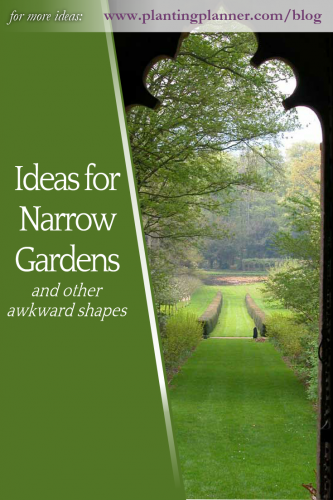from The Weatherstaff PlantingPlanner – intelligent garden design software
When is a triangle not a triangle?
Our main garden is an elongated, right-angled triangle, bordered by a wild hedge edging a country lane. When we first moved in, the entire garden was laid to lawn and could be viewed in all its triangular, tapering glory! Pythagoras might have been delighted with the opportunity to experiment with the properties of our triangle. We were more perplexed by the dilemma of how to make a triangle look more like a rectangle!
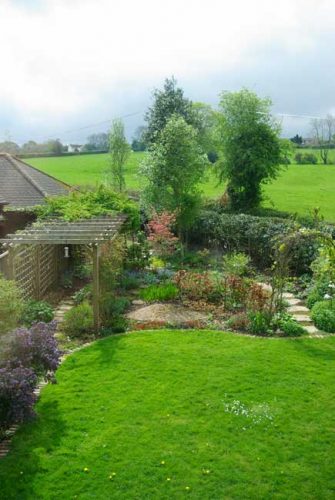
In our vast expanse of grassness, we were also keen to add interest by creating pathways and hidden areas, as well as planting up flower borders to soften the boundaries.
We ended up making the lawn area smaller, with a more curvy shape, by lopping off the tip of the triangle. We laid stepping stones to create a winding pathway up to the tip of the triangle and used taller planting to obscure the shape.
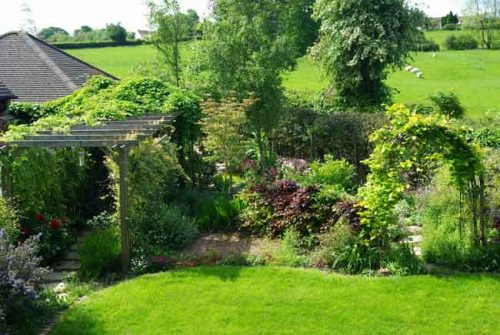
As the planting started to become established, the stepping stones began to disappear into our secret garden.
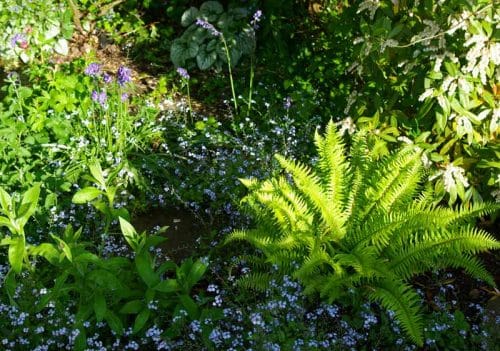
We planted a pair of columnar silver birches, their narrow lines perfect for small gardens, and used plants which naturally favour woodland conditions.
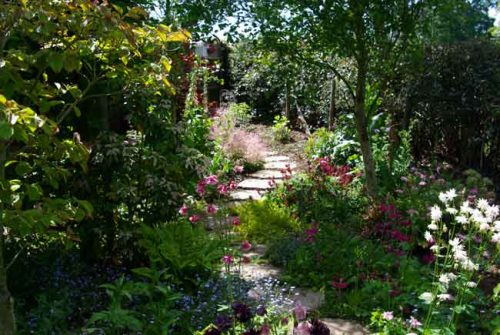
It has become our wild area – not least because it’s not so visible from the house so is always last on the weeding list!
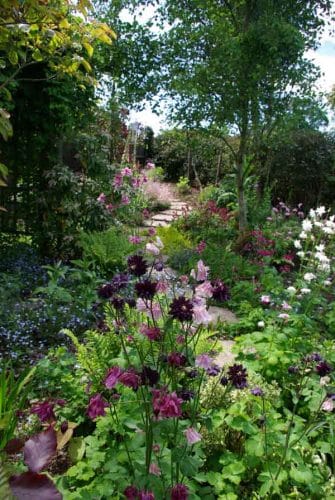
This area of the garden is glorious in spring, when the aquilegias, candelabra primulas and forget-me-nots are all in flower. In summer, the geraniums, hydrangeas and persicaria do well.
I tried hostas up here, as they are a perfect choice for a shade garden, but they were too far from the house for me to remember to slug-proof them and I decided to move them nearer to the back door where I could keep a wary eye on them.
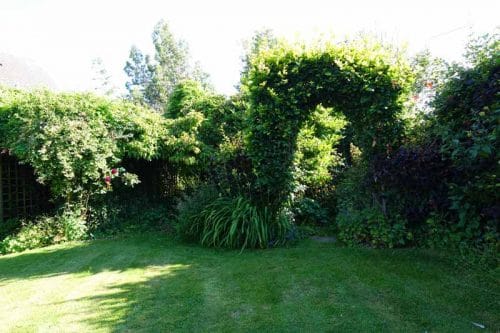
Over time, the shrubs have grown tall and the planting has become dense and overgrown. It’s definitely time for another make-over – or at least, a good sort-out and pruning session, but the basic structure and pathways are still good and I’m happy that the garden no longer looks too angular.
Disguising awkward shapes
Changing the shape of features such as lawns and planting areas can help disguise unusual shapes and smooth out sharp angles. Circles (or even octagons) make interesting lawn shapes as they create intriguingly-shaped borders around their edges and draw the eye away from the less-than-perfect outline.
Splitting up the overall garden into sections, especially where there is a journey to follow to reveal each part, can be a clever way to disguise an unusual shape.
Ideas for long, narrow gardens
I appreciate that dealing with a triangular garden is not a problem too many people have. A much more common garden shape is the long, narrow plot and the geometrical puzzle becomes how to make a narrow rectangle look like a circle – or even a square!
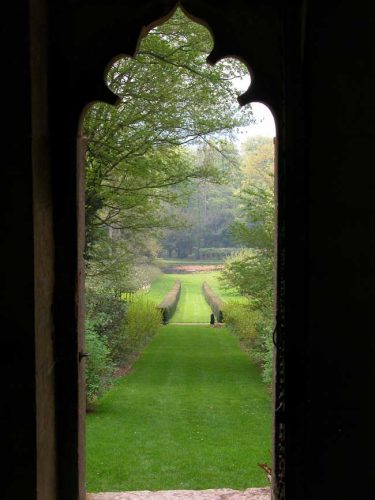
If you have a grand estate to play with. long, straight vistas are rather wonderful. But in a ‘normal’ back garden, the idea is to break up the linear view.
You know the fashion advice – if you’re short and dumpy, vertical stripes are better; beanpoles look better proportioned if the stripes are horizontal. The same ploy works for gardens. For plots which are long and narrow, you need to trick the eye into looking from side to side, instead of along the length. (Of course, if your garden is wide and shallow, you can use the same tricks – this time emphasising the length instead of the width.)
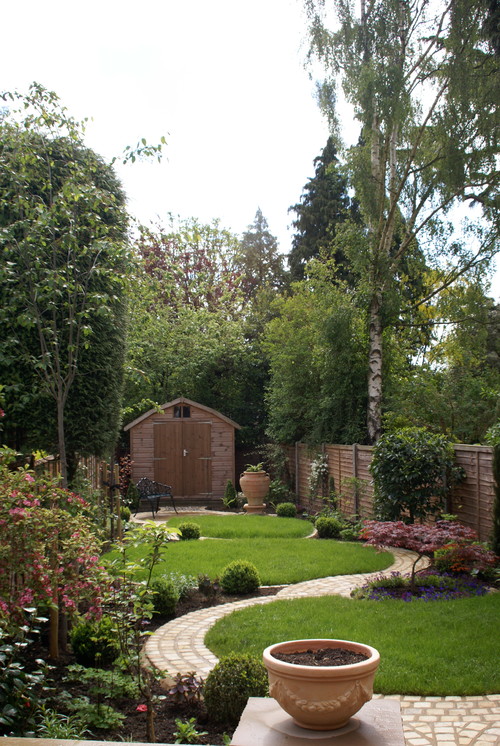
So instead of laying a path which runs straight down the length of the garden, create sinuous, walkways, with interesting features along the way, to create different vantage points as you walk through the garden.
More ways to break up the linear look:
- Place a path, seating area or pond widthways across the garden.
- Lay an area of decking so that the planks lie across, instead of down the length of, the garden.
- Place large objects, such as urns or a sundial, at the edges of the plot,to draw the eye across, instead of down, the garden.
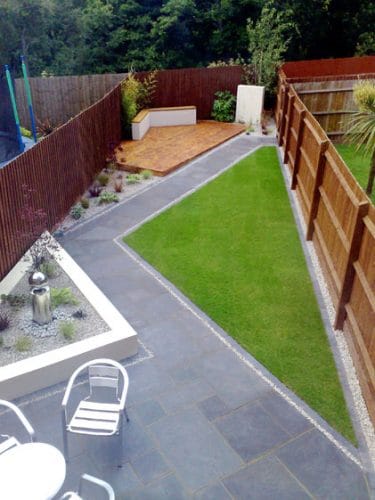
Think about setting paths and open spaces, like a lawn or sitting areas, on the diagonal. Or split long gardens into sections horizontally, giving each section its own distinctive role and style e.g. an alfresco dining area, a lawn area, the kitchen potager.

Garden designers often recommend building in ‘obstructions’, to prevent the whole garden being seen at once. Try adding arches, obelisks or fencing panels, clothed with climbers, so that each section of the garden is revealed in turn. Tall planting can also be used in this way.
Choosing the right plants
Once you’ve got the basic structure right, it’s time to think about updating tired garden borders or choosing plants for new flower beds. For plantaholics, that’s where the fun begins!
If you need help selecting plants to make a stylish border, you could try The Weatherstaff PlantingPlanner. This interactive gardening software designs all-season planting plans, choosing plants which are tailored to your garden’s growing conditions. You can satisfy your inner garden designer by tweaking and modifying each plan until it is just how you want it to look!
Find out more here.
Pin for later
For more gardening ideas, click here to follow the Weatherstaff PlantingPlanner on Pinterest.





